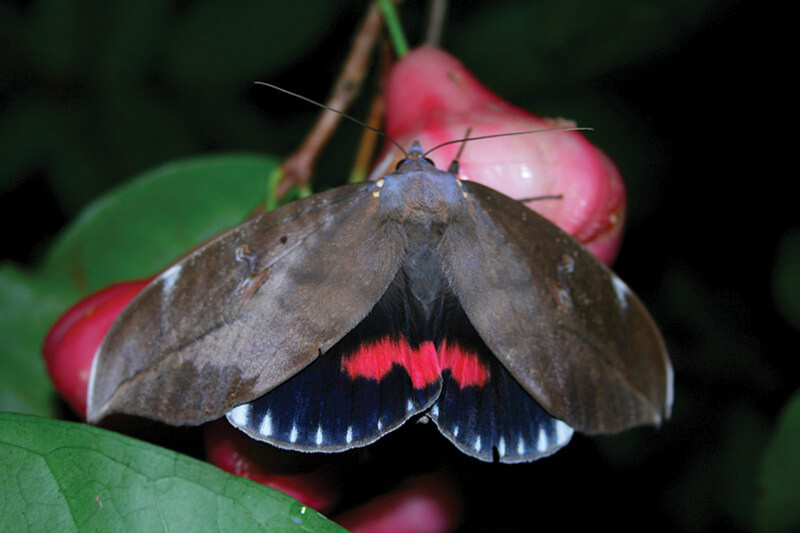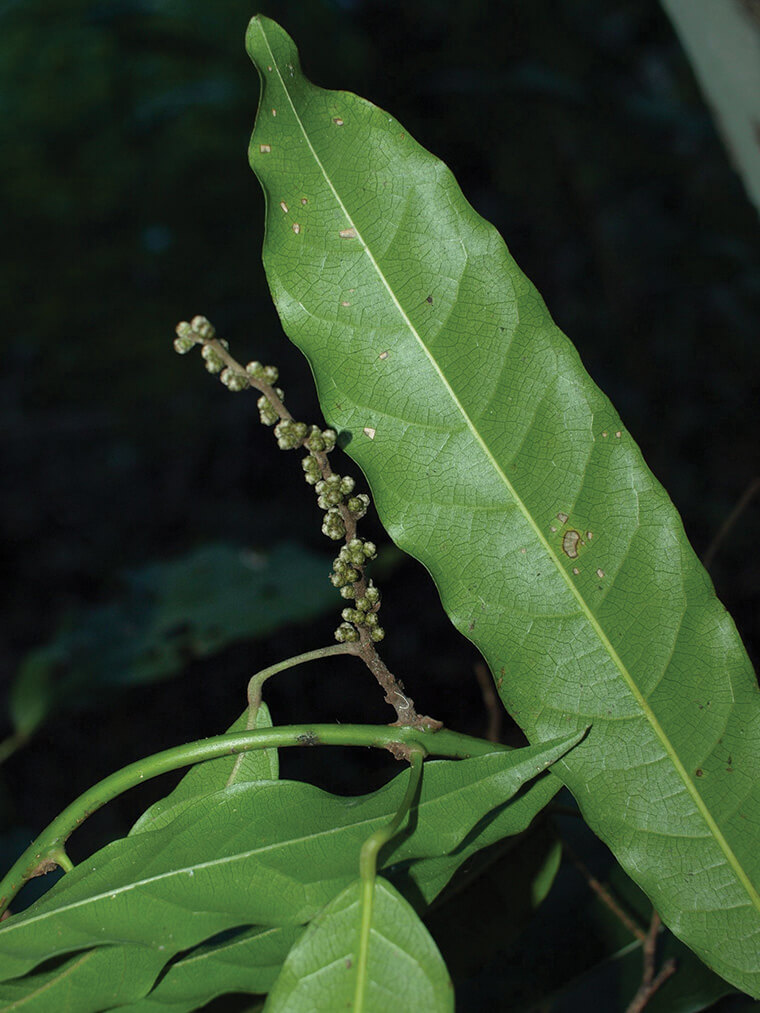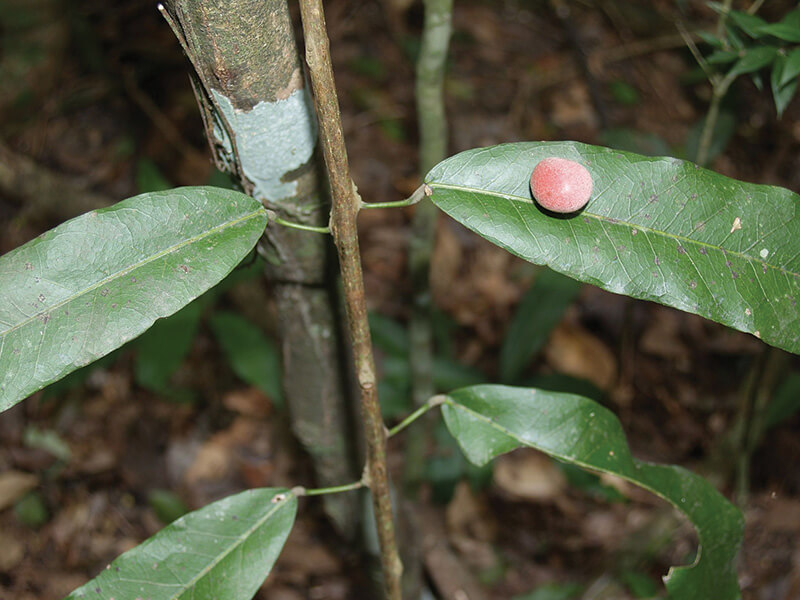
Tucked deep in the shady understorey of rainforest remnants scattered between Bellingen in NSW and Kin Kin in Qld, a remarkable moth lives out its secretive lifecycle.
Work over the past three decades by retired CSIRO research scientist Dr Don Sands (OAM), brought this amazing moth into the limelight, exposing its incredible ecology, threatening processes and of course, its superstar looks!
The Southern Pink Underwing (Phyllodes imperialis subsp. smithersi) moth grows to 16cm across and has striking colours. The front-wings are broad and deep brown with incredible markings that make the wings appear like a dead leaf. It even has a small white ‘leaf miner scar’ imitation in the centre, which makes it even more camouflaged when it sits motionless, wings closed, during the daylight hours. If the moth gets startled, it flashes its leaf-like wings to reveal the hindwings which are blotched fluorescent pink.

The moth has one of the world’s most exotic and eccentric looking larva. It grows to an impressive 10-12cm long and is marked all down its flanks with opalescent brown, beige, aqua and pink. Like most caterpillars, this one has relatively small and indistinct head eyes; however, right behind the head are a couple of segments that are covered in white ‘tooth-like’ markings and atop those, two huge blue false eyes with piercing black pupils. When you give this guy a fright, be prepared for a shock of your own as the larva lunges forward folding its real head inside the fleshy upper segments engorging the false teeth and eyes so that it appears like a tiny dragon is about to bite you. All of this, of course, is a show where the caterpillar has evolved such markings to keep its otherwise juicy, tasty body safe from birds and mammals that it shares its rainforest home with.
Dr Sands’ work also discovered its sole dependency on one unassuming rainforest vine, Carronia (Carronia multisepalea). This unusual plant is a rainforest specialist growing in primary rainforest and sometimes on disturbed rainforest edges. It is a member of the Menispermaceae family, which is a group of somewhat-toxic woody vines distributed across the southern hemisphere. Quite a number of moth larvae related to the Southern Pink Underwing also feed on vines belonging to the Menispermaceae family. Carronia is typical of this family in having fairly indistinct little olive-coloured flowers, a straggly vine-like growth form and characteristic elbow-shaped leaf-stalks.

How are the Carronia vine and the Southern Pink Underwing connected?
Like all moth and butterfly caterpillars, the Southern Pink Underwing moth larva is fussy when it comes to food. For the Southern Pink Underwing, it has developed a special relationship with the Carronia vine. As more and more of our dark, cool lowland rainforest remnants are removed, many plant species with specific roles as foodplants disappear, and with them the insects that depend on them. Sadly, while the Carronia vine is still found in decent numbers, the moth, due largely to fragmentation of those remaining Carronia-containing rainforest patches, is now listed as Endangered under the Commonwealth’s Environmental Protection and Biodiversity Conservation (EPBC) Act.
What can we do to help reverse the decline?

As part of the Back from the Brink docu-series created by Natura Pacific, a team is working with Native Plants Queensland’s Dr Bonni Yee, as well as Dr Sands, to propagate up to 10,000 young Carronia vines. The team is using specialised culture methods in a Sunshine Coast laboratory to repopulate suitable rainforests and rainforest edges across the region. Selecting from a number of sites at varying locations across SEQ, fruits and cuttings of Carronia are now being sought and taken to the lab and placed into special growing media to give the baby vines a good chance to establish.
This is where landholders like yourselves come in! We are hoping that we can get interest from Land for Wildlife members to keep an eye out for Carronia vines or their small round pinkish-red fruit. Please let us know if you have healthy vines on your property, or if you are able to collect some fruits. We can then arrange for the cuttings and/or fruit to be collected from your property and sent to the lab to be included in this effort to produce young vines for the moth. Once grown, Natura Pacific’s Dr Mark Nadir Runkovski will work with Dr Yee to provide a male and female Carronia vine (they’re dioecious organisms – they have separate male and female plants) along with a small Syzygium species (our native lillipillis) to our local councils within the moth’s native range.

From the Sunshine Coast to Byron Shire, we aim to help councils and private landholders plant healthy, genetically-vigorous male and female vines along with the fruiting lillipillis to allow more land parcels to develop into potential breeding spots for the moth. The vines will provide the foodplants for the caterpillars and the lillipillis provide food for the adult moths that suck the sugars from damaged and decaying rainforest fruits.
Ultimately, with support from councils and landholders, we hope to replicate the huge success of the work done by Dr Sands and the Richmond Birdwing Conservation Network over the past 20 years in recovering the similarly rare and beautiful Richmond Birdwing butterfly.
How do I get involved?
If you wish to register with this project and check your property for Carronia vines please send an email to the project coordinator, Dr Mark Nadir Runkovski at his email shown below.
You can also learn more about our docu-series, including the video on the Southern Pink Underwing, by searching ‘Natura Pacific – Back from the Brink’ on YouTube or listen to our podcasts on Spotify, Amazon Audible, Apple or Google Podcasts. Together, we can help save this remarkable moth from extinction.
Dr Mark Nadir Runkovski
Natura Pacific
mark.runkovski@natura-pacific.com

Hi Friends
Lismore Rainforest Botanic Gardens would love to add this vine to our collection. Can you please let me know how we might get seed or plants.
Regards
Peter Gould
Co-curator Lismore Rainforest Botanic Gardens.
Hi Peter
Probably best to contact Mark who authored the article and is coordinating this project – mark.runkovski@natura-pacific.com
Have sent an email. Yes luv to have a go at propagating this vine from seed.